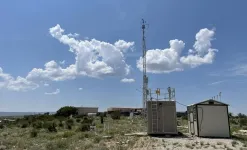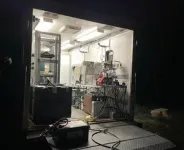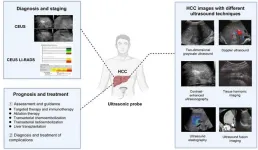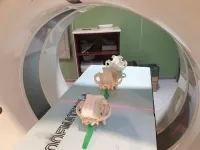(Press-News.org) EMBARGO: THIS CONTENT IS UNDER EMBARGO UNTIL 9 A.M. U.S. EASTERN STANDARD TIME ON JULY 16. INTERESTED MEDIA MAY RECIVE A PREVIEW COPY OF THE JOURNAL ARTICLE IN ADVANCE OF THAT DATE OR CONDUCT INTERVIEWS, BUT THE INFORMATION MAY NOT BE PUBLISHED, BROADCAST, OR POSTED ONLINE UNTIL AFTER THE RELEASE WINDOW.
New research shows that ozone concentrations at Carlsbad Caverns National Park frequently exceed Environmental Protection Agency health standards, likely due to oil and natural gas development in the Permian Basin and surrounding region.
The work was led through the Department of Atmospheric Science at Colorado State University and is part of ongoing air quality research across the national park system by University Distinguished Professor Jeffrey Collett and his team. Andrey Marsavin, a Ph.D. student in the department, served as first author on the work, which was published in the Journal of Geophysical Research-Atmospheres.
The park is in southeast New Mexico and in the summer frequently sits downwind from the Permian Basin – one of the largest and most productive oil and natural gas areas in the country. Data from the paper comes from a 2019 field survey and is part of a series of air quality studies in the area. The paper shows that eight-hour ozone concentrations frequently exceed the EPA health standard of 70 parts per billion during the summer months.
Marsavin said the research explores the different potential sources of ozone precursors in the area and confirms that oil and gas development – which has increased fivefold in the basin over the last decade – is a major contributor.
“Our model focused on specific compounds that are known to be associated with oil and gas production to help us understand how that activity specifically contributes to the ongoing ozone issues in the region,” he said. “Our measurements confirm that activity such as drilling and natural gas flaring is a major driver of the high ozone levels we see.”
Unhealthy ozone concentrations are a serious problem worldwide, including urban areas like Colorado’s Front Range. It can lead to health issues in humans such as asthma, while also damaging crops and natural ecosystems.
Ozone is a highly reactive gas that forms when emissions from both natural sources and human activities react in the atmosphere. Major sources of ozone precursors include motor vehicles, industrial facilities, solvents and coatings, personal care products, vegetation, and lawn and garden equipment. Energy exploration and production systems like those found in the Permian Basin are also large contributors to emission totals.
Tracking ozone levels near Carlsbad and other national parks
Federal requirements have helped reduce U.S. emissions of nitrogen oxides and volatile organic compounds that can lead to ozone over the last 20 years. However, some areas of the western U.S. have only seen small declines or even increases due to wildfire activity, increased oil and gas development, and production activity like flaring and fracking.
Marsavin said a goal of this research was to untangle possible sources of ozone precursors in the region and quantify the impact of extensive oil and gas development on high ozone concentrations. The team found that while both nitrogen oxides and volatile organic compounds contribute to ozone, the largest impact comes from nitrogen oxide emissions. These emissions come primarily from high-temperature combustion activity. They then tracked dispersal patterns across the region to show that activity in the Permian Basin was a primary driver, with emissions from other oil and gas basins farther upwind appearing to also contribute to elevated ozone on some days.
The team’s research also considered how a switch in production methods such as the use of electric power for drilling rigs could lower ozone levels in the area.
Professor Collett’s team has partnered with the U.S. National Park Service on a range of air quality research projects for years. He said this paper’s findings were likely relevant to nearby areas like Guadalupe Mountains National Park in Texas and the broader region.
He said the team will continue to work with more recently collected data and potentially begin to include satellite observations in their approach as well.
“Many of the country’s largest oil and gas production basins are located near national parks. These are fragile ecosystems that the park service is entrusted with protecting for everyone – so they are very interested in these findings and how actions can be taken to address them,” Collett said. “So, we are not quite done with studying ozone formation in this region as development in the Permian continues.”
The research was done in partnership with the National Park Service’s Air Resources Division, and NPS scientists Barkley Sive, Bret Schichtel and Anthony Prenni are co-authors. Other CSU-affiliated authors on the work include Monfort Professor Emily Fischer; research scientists Yong Zhou, Ilana Pollack, Amy Sullivan, Da Pan and Katherine Benedict; and graduate students Lillian Naimie and Julieta Juncosa Calahoranno.
END
Oil and natural gas development in Permian is a key source of ozone pollution in Carlsbad Caverns National Park
Paper shows that eight-hour ozone concentrations frequently exceed the EPA health standard during the summer months
2024-07-16
ELSE PRESS RELEASES FROM THIS DATE:
E. coli variant may cause antimicrobial resistance in dogs, humans
2024-07-16
ITHACA, N.Y. – Researchers studying antimicrobial-resistant E. coli – the leading cause of human death due to antimicrobial resistance worldwide – have identified a mechanism in dogs that may render multiple antibiotic classes ineffective.
The paper, which will publish July 16 in the journal Applied and Environmental Microbiology at 9:00am EST, opens up new avenues for therapies to treat both animals and humans – and establishes clinical infections in dogs as a surveillance approach for public health.
The research team analyzed more than 1,000 genomes of the resistant ...
Ultrasonography of hepatocellular carcinoma: From diagnosis to prognosis
2024-07-16
Hepatocellular carcinoma (HCC) is a primary malignancy of the liver and one of the leading causes of cancer-related deaths worldwide. Early detection and accurate diagnosis are crucial for effective management and improved survival rates. Ultrasound (US) technology has significantly advanced and plays a pivotal role in the surveillance, diagnosis, and treatment of HCC. This paper delves into various ultrasound techniques and their clinical applications in HCC management.
Two-dimensional gray-scale ultrasound is a fundamental imaging technique for HCC surveillance. ...
Partisan politics and perceptions of immorality
2024-07-16
Democrats and Republicans overestimate the percentage of people in the opposing party who approve of widely agreed-upon moral wrongs, such as theft or animal abuse, according to a study. Today, Americans hate their opposing political party more than they love their own party, and political animosity and dehumanization of opposing party members have been on the rise for decades. Curtis Puryear and colleagues looked for a “basic morality bias” in social media posts from 5,806 political partisans by searching for words that referencd ...
Should AI be used in psychological research?
2024-07-16
Mohammad Atari and colleagues explore the promise and peril of using large language models (LLMs) in psychological research, beginning by urging researchers to also ask themselves whether and why they should use LLMs—not just how they should use them. The authors caution against using LLMs as a replacement for human participants, noting that LLMs cannot capture the substantial cross-cultural variation in cognition and moral judgement known to exist. Most LLMs have been trained on data primarily from WEIRD (Western, Educated, Industrialized, Rich, Democratic) sources, disproportionately in English. Additionally, although ...
AI makes human-like reasoning mistakes
2024-07-16
Large language models (LMs) can complete abstract reasoning tasks, but they are susceptible to many of the same types of mistakes made by humans. Andrew Lampinen, Ishita Dasgupta, and colleagues tested state-of-the-art LMs and humans on three kinds of reasoning tasks: natural language inference, judging the logical validity of syllogisms, and the Wason selection task. The authors found the LMs to be prone to similar content effects as humans. Both humans and LMs are more likely to mistakenly label an invalid argument as valid when the semantic content is sensical and believable. LMs are also just as bad as humans at the Wason selection task, in which the participant ...
Waterpower scarcity and coal use during the Industrial Revolution
2024-07-16
A study combining history, economics, and fluvial geomorphology examines the causes of the adoption of coal power during the Industrial Revolution in Great Britain. At the beginning of the mechanization of the textile industry in Britain, most machines were powered with waterpower. Eventually waterpower was replaced by using coal to make steam power and the causes of this shift have long been debated. One influential hypothesis has been that waterpower became scarce in the industrial heartland of northwest England during the early 19th century, as all available suitable sites were already fitted with ...
Capturing carbon with energy-efficient sodium carbonate−nanocarbon hybrid material
2024-07-16
Industrial emissions are one of the main sources of climate change-inducing carbon dioxide (CO2). While adopting renewable and clean energy alternatives is one option for mitigating these carbon emissions, carbon capture technology is another solution to control CO2 emissions. In big CO2-emitting industries, such as cement, oil refineries, and thermal power plants, carbon capture technology can be easily applied to remove CO2 emissions directly at the source at a feasible cost and with low energy consumption. Different materials have been explored for CO2 capture in factories, including zeolites, metal−organic frameworks, natural minerals, alkalis, ...
Digital dog and cat skull database
2024-07-16
The ELTE Eötvös Loránd University is home to the skulls of more than 150 dog breeds and other animals. To make this unique collection accessible to all, researchers digitised the skulls of 431 dogs, cats and wild relatives. The database can be used for educational and research purposes.
Tibor Csörgő, a researcher at ELTE, has been collecting animal skulls for decades to teach anatomy to biologists. The shape of the skull varies considerably between species and breeds, especially in dogs, where, for example, greyhounds have long skulls and the now popular French bulldogs have rounded skulls.
A skull biobank ...
Breaking through silicon
2024-07-16
Overcoming Historical Barriers
Silicon, the cornerstone of modern electronics, photovoltaics, and photonics, has traditionally been limited to surface-level nanofabrication due to the challenges posed by existing lithographic techniques. Available methods either fail to penetrate the wafer surface without causing alterations or are limited by the micron-scale resolution of laser lithography within Si. In the spirit of Richard Feynman's famous dictum, 'There's plenty of room at the bottom', ...
A new study finds that early detection of miRNAs in maternal blood may offer the potential for predicting preeclampsia
2024-07-16
Preeclampsia (PE) is a significant contributor to the increase in maternal morbidity and mortality worldwide, with particularly alarming numbers in the United States, where it affects about 2–8% of pregnancies, resulting in premature birth with associated morbidities for their infants as well. A new study by researchers at UCLA Health finds that early detection of specific microRNAs (miRNAs) packaged in vesicles may offer the opportunity to predict preeclampsia in pregnant people before clinical symptoms manifest.
The study, led by Dr. Sherin U. Devaskar, MD, executive chair of the Department of Pediatrics ...
LAST 30 PRESS RELEASES:
DNA tests reveal mysterious beluga family trees
Strategic sex: Alaska’s beluga whales swap mates for long-term survival
How early cell membranes may have shaped the origins of life
Cannabis legalization is driving increases in marijuana use among U.S. adults with historically lower consumption rates
Multifunctional dipoles enabling enhanced ionic and electronic transport for high‑energy batteries
Triboelectric nanogenerators for future space missions
Advancing energy development with MBene: Chemical mechanism, AI, and applications in energy storage and harvesting
Heteroatom‑coordinated Fe–N4 catalysts for enhanced oxygen reduction in alkaline seawater zinc‑air batteries
Meta-device for precision lateral displacement sensing
Plasma-guided mitotane for the treatment of adrenocortical carcinoma: adjuvant care to advanced disease
Theoretical study of laser-enhanced nuclear fusion reactions
Social environment impacts sleep quality
Optimized kinetic pathways of active hydrogen generation at Cu2O/Cu heterojunction interfaces to enhance nitrate electroreduction to ammonia
New design playbook could unlock next generation high energy lithium ion batteries
Drones reveal how feral horse units keep boundaries
New AI tool removes bottleneck in animal movement analysis
Bubble netting knowledge spread by immigrant humpback whales
Discovery of bats remarkable navigation strategy revealed in new study
Urban tributaries identified as major sources of plastic chemical pollution in the Yangtze River
UK glaucoma cases higher than expected and projected to reach 1.6 million+ by 2060
Type 2 diabetes prevention could more than halve carbon footprint linked to disease complications
Over 1 million estimated to have glaucoma in UK
Early treatment can delay rheumatoid arthritis for years
National childhood type 1 diabetes screening is effective and could prevent thousands of emergency diagnoses, UK study shows
Mix of different types of physical activity may be best for longer life
Continuous care from community-based midwives reduces risk of preterm birth by 45%
Otago experts propose fiber as first new essential nutrient in 50 years
Auburn Physics PhD student earns prestigious DOE Fellowship
AI tool helps you learn how autistic communication works
To show LGBTQ+ support, look beyond Pride Month
[Press-News.org] Oil and natural gas development in Permian is a key source of ozone pollution in Carlsbad Caverns National ParkPaper shows that eight-hour ozone concentrations frequently exceed the EPA health standard during the summer months







